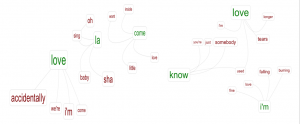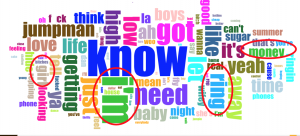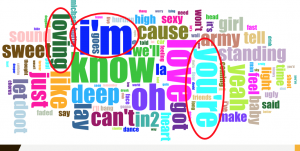AN ANALYSIS OF LYRICS (So Far…)
The question that I initially had was regarding the differences between songs that are considered to be happy and songs that are considered to be sad. Are there differences in the lyrics? What makes lyrics “happy” or “sad”?
My first step was to create both happy and sad corpora. I was able to utilize Spotify for this because they create playlists based off of mood. It was very easy to find a playlist about being happy, while it was far more difficult to find a playlist of sad music. This made me think about the social pressures for people to be happy. I thought that this could be a signal that it is less socially acceptable for a person to be sad than it is to be.
Cleaning the lyrics was a bit of a chore, but was not as taxing as it could have been. I googled all of the names of songs and copied and pasted them into word documents, when I copied and pasted them, there were many things that needed to be deleted such as brackets, chorus/verse indicators, and parenthesis. There were also many instances in which the chorus was written once followed by a: [x2]. These needed to be removed and the chorus was copied so that the repeating of lyrics was accurate. I think it was important to include the repeating of lyrics because this signifies that the words being said are important to the song.
Voyant
Voyant was an interesting program to work with because of the visuals that it can create for the viewer. I found a majority of the visuals to be more cool to look at and less data based. I think that the Link tool, the document trends, and the collocate tools were all very helpful to learning more about my texts. The summary of the text was also helpful. 
AntConc
I did not get as much out of AntConc as I would have liked. The main thing that I did with AntConc was look at word frequency, I looked at the amount of pronouns in the different moods of music. I recorded many more pronouns being used in the happy songs compared to the sad one. There were some possessive pronouns the happy songs, while there were none in the sad songs. This leads me to believe that there could be a sort of denial that is going on in the sad song lyrics, whereas the happy lyrics are more open.
Changes to the Project
I decided that I should broaden my corpus or create a corpus to compare my first one to. I took the top 40 songs from both the US and the UK and created a corpus of the songs. So far, the main thing that I have looked at in these collections of lyrics is word frequency. The most frequent words in both US and UK top 40s include “I’m” and “know”, which are also frequent words in the collection of sad songs. “I’m” is a word that is a frequently used in all of the corpora. I think that this could show us that whether happy or sad, US or UK, there is always an undertone of individualism and maybe narcissism
. 

My New Question: What role do the lyrics to a song play in making a song “Happy” or “Sad” and how can we take what we learn about lyrics and apply it to the Top 40 lists of both the USA and United Kingdom?
Remaining Tasks as of now:
- Figure out how to work Poemage to analyze rhyme scheme.
- Work on Jigsaw analysis of sentiment with a reference corpus